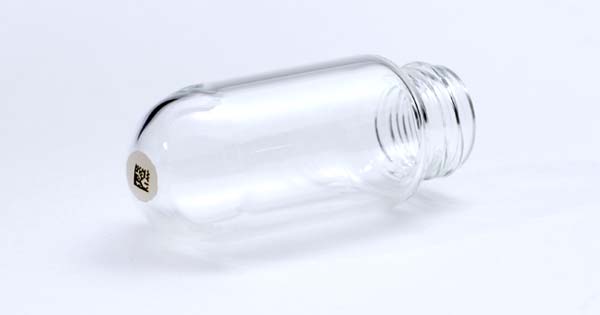Reliable barcodes and labels in the laboratory are crucial, as you are often dealing with human samples and specimens or chemical tests that require tracking accuracy and high ethical standards. Another thing to note is that labeling is typically not ‘one size fits all,’ meaning that all laboratory processes are different, and have different label requirements and specifications based on individual research, protocol, and structure.
Due to the importance of maintaining the integrity of samples or containers, and the confidence that your lab is correctly identifying, tracking, and managing samples, as a labeling expert we are often asked, “Why are barcode labels failing in my lab?”
Simply put, lab processes and sample storage often require harsh environments; therefore labels typically require specialized engineering to withstand such extreme temperatures, chemical exposure, and storage environments. In this article, we will describe six reasons we commonly encounter that could result in the reason the labels in your lab are failing.
1. The labels you’re using are not engineered for your specific application
Lab environments can be very tough, which is why it is beneficial to ensure your labels have been specifically engineered for your application and to withstand the extreme environments they will encounter.
For instance, paper labels that you might typically use for packaging or storage are not engineered for or intended to be chemical resistant. Labels of this nature would likely dissolve if exposed to harsh chemicals or a solvent bath, which many samples in the traditional lab will encounter.
Longevity is also vital for labels in a lab environment. The label has to accommodate the sample or test throughout its entire intended life, however long that may be. When dealing with human samples especially, it is essential that the label is capable of lasting throughout the entire process.
2. Lab exposures and usage terms are harsh
There are two different types of harsh environments that labels in the lab may have to withstand:
Chemicals
The use of chemicals is typically to dry samples out, utilize color to define test results, and clean or sterilize labware.
All of these processes require very harsh chemicals that are designed to dissolve almost everything they come in contact with. This makes it even more important that your labels are designed to withstand harsh chemicals such as DMSO, methanol, acetone, isopropyl alcohol, and water.
To ensure that your labeling solutions are tailored to your unique needs and environment, we highly recommend conducting a comprehensive site survey or engaging in a conversation with a label expert. This consultation will prove invaluable in determining the precise requirements of your labels, taking into account factors like whether a simple wipe with alcohol is part of your process or if your samples must endure extended immersion in a water bath for 24 hours.
Such detailed information is paramount in selecting the ideal combination of face-stock and adhesive/laminate for your labeling needs.
It’s important to note that not all labels designed for harsh environments are created equal. Some exhibit greater resistance to specific chemicals or environmental conditions than others. To ensure you receive labels that are the perfect match for your process, it’s essential to communicate all your specifications clearly to your supplier. By doing so, you can rest assured that you will receive labels that not only meet but exceed the demands of your unique laboratory setting and testing processes.
Temperatures
Extreme temperatures are also common environments for samples to endure. High heat may be used for cleaning or sterilizing, and this often takes place in an autoclave.
On the other hand, extremely cold temperatures or cryogenic storage environments are also very common in a laboratory setting. Cryogenic environments require specialized cryo-resistant labels. Cryogenic storage temperatures range from -20°C to -196°C, and if the labels are not engineered to withstand such wide temperature ranges, the labels could become very brittle and even break off.
Additionally, with the use of plastic containers, there is the challenge that a change in temperatures can cause plastic to expand or shrink, and the label will not always do the same. This could cause the label to peel, flag, or for the adhesive to be exposed and freeze, hindering the label from properly sticking.
Computype’s Direct Mark offering is a solution to this problem, as there is no label, but rather the barcode or image is directly marked onto the surface of the container and has been tested to survive in harsh conditions.
Another cryo labeling solution is the wraparound label, which will remove the problem of flagging, as the adhesive wraps fully around the container and adheres back onto itself, providing both extra adhesive surface area and eliminating the barcode image from ever coming into direct contact with external environments.
3. Incorrect application method
The application method is important when you are labeling samples; especially ones that are required to withstand harsh environments.
A common reason that labels will fail in cryogenic storage environments is that the label was applied to an already frozen container without the frost being wiped off. If you try to adhere a label directly to frost, the frost has the chance of melting into water, which will eventually evaporate and the label will no longer stick as the surface area will be wet. It is important to wipe the frost off before attempting to affix any kind of label to a container.
Oftentimes the most efficient and safest way to apply labels to tubes or vials is via label automation. If labels are applied manually and the adhesive is accidentally touched or rubbed, it can ruin the effectiveness of the adhesive.
Additionally, the labels are often too small to successfully or precisely hand-apply, which increases the chance that the labels may not be fully adhered, tending to flag or peel. Through utilization of automated labeling systems it is guaranteed that the intended adhesive remains intact, with the best chance of reaming permanently affixed.
4. Wrong print technology or ribbon/ label combination
If you are not utilizing the best print technology or ribbon/label combination for your laboratory labels, it may cause the label image to fade or be unreadable. Below, we have outlined three different kinds of print technology, and what type of application they are the best fit for.
Ceramic Labels
Ceramic labels are intended for glass containers and are fit to survive in extreme environments and temperatures.
They are permanently fired onto glass containers through a label supplier, so it is important to note that ceramic labels are not an option if the information required on the label is not known in advance.
Ceramic labels are most commonly used in compound storage applications within pharmaceutical or biotechnology organizations.
Direct Mark
This is a Computype-specific option available through our Labware Prep™ Services offering.
Proprietary technology enables direct marking of colors, barcodes, logos, or text to glass or plastic containers that can withstand limited exposure to chemicals.
Direct mark is a great option for labs that are utilizing plastic containers and need a barcode or image to survive; adoption of this solution typically is successful in solving common lab labeling failures.
Utilization of color marking also enables labs to match containers with caps or paperwork, further streamlining processes and reducing errors.
Pressure Sensitive
This is the most common labeling method—harsh-environment engineered labels are durable, and can withstand general exposure to chemicals.
The wraparound label is also a durable option, as it will wrap completely around the container, adhering to itself rather than relying solely on the container.
Cryo resistant pressure sensitive labels are a great option if you need on-demand and variable printed labels.
Beware though, that if you are printing on-demand via thermal transfer print technology and don’t have the optimal label and ribbon combination, any exposure to abrasion, solvents, or ink could cause the label image to be broken, chipped away, or rubbed off.
Without the correct materials and ribbon combination, the label image may simply not be durable enough to survive or withstand the harsh environments your lab requires.
5. Inconsistent label placement
This common problem emphasizes the benefits of automation, as manual labeling is almost always inconsistent to some degree. If label placement becomes a problem, the rest of an automated process will be thrown off, compromising the integrity of the sample and the associated test.
Oftentimes, if automation is not used throughout the entire process, it is implemented somewhere along the way.
Automation is utilized in order to promote precision; when inconsistent label placement occurs, it can cause associated automation processes in the lab to fail downstream due to misread barcode scans or worse, failed scans.
While the label itself is not necessarily failing, the varying placement on the labware can cause issues with the larger automated process in your lab.
At Computype, we strongly promote the use of label automation or an outsourced labeling program to improve label placement accuracy; the degree of precision and consistency is much more reliable, and errors/rework will be greatly reduced as a result.
6. Compatibility of label size with labware
It is important that your label not only fit correctly with the shape and size of your tubes and vials, but your other labware, including storage and racks. It is a common issue that once labels have been applied to tubes and vials, they will no longer fit into their respective rack, as the circumference of the container has now been expanded by the placement of the label.
If you are using a label, it adds thickness to the outside diameter of the tube. Most racks are made to only allow space for the tube itself so as to avoid jarring or movement. If the racks are not designed to accommodate the increased diameter correctly, it could cause the label to crinkle, come off, or stick to the rack.
A solution to this problem is the option of utilizing ceramic or direct mark technology through outsourcing, with an offering like Labware Prep™ Services, where your labware is pre-barcoded and pre-packaged. This way, the potential problem will be addressed and solved before it even reaches your lab.
If outsourcing is not an option, you will need to plan and accommodate for the extra circumference when choosing your storage racks.
For obvious reasons, it is very important that the labels in your lab are successful for their intended use. At Computype, we provide labeling solutions for laboratories around the world, and have had over 40 years of experience in successfully helping the healthcare industry to track, manage, and identify samples.
Through the years, these six problems have been the consistent ones we most encounter. We hope that after reading this article, you can pinpoint the reason labels may be failing in your lab, and take the next steps to prevent further headaches.
Additionally, if you have issues with labels in the lab that weren’t addressed above and would like a call back from one of our experts, let us know and we will be happy to step in and help.
Connect with our labelling experts today
Blog article form
"*" indicates required fields














